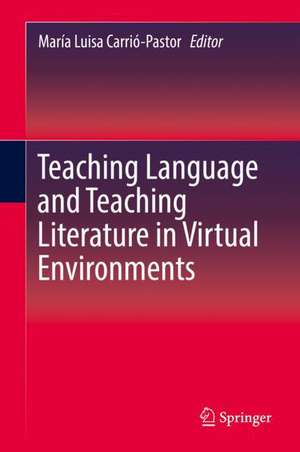Teaching Language and Teaching Literature in Virtual Environments
Editat de María Luisa Carrió-Pastoren Limba Engleză Hardback – 27 sep 2018
| Toate formatele și edițiile | Preț | Express |
|---|---|---|
| Paperback (1) | 528.48 lei 6-8 săpt. | |
| Springer Nature Singapore – 19 ian 2019 | 528.48 lei 6-8 săpt. | |
| Hardback (1) | 704.04 lei 6-8 săpt. | |
| Springer Nature Singapore – 27 sep 2018 | 704.04 lei 6-8 săpt. |
Preț: 704.04 lei
Preț vechi: 828.27 lei
-15% Nou
Puncte Express: 1056
Preț estimativ în valută:
134.72€ • 141.01$ • 112.13£
134.72€ • 141.01$ • 112.13£
Carte tipărită la comandă
Livrare economică 31 martie-14 aprilie
Preluare comenzi: 021 569.72.76
Specificații
ISBN-13: 9789811313578
ISBN-10: 9811313571
Pagini: 293
Ilustrații: XXI, 293 p. 50 illus., 38 illus. in color.
Dimensiuni: 155 x 235 x 18 mm
Greutate: 0.62 kg
Ediția:1st ed. 2019
Editura: Springer Nature Singapore
Colecția Springer
Locul publicării:Singapore, Singapore
ISBN-10: 9811313571
Pagini: 293
Ilustrații: XXI, 293 p. 50 illus., 38 illus. in color.
Dimensiuni: 155 x 235 x 18 mm
Greutate: 0.62 kg
Ediția:1st ed. 2019
Editura: Springer Nature Singapore
Colecția Springer
Locul publicării:Singapore, Singapore
Cuprins
Section 1. Methodology Design for Second Language Teaching in Virtual Environments.- Chapter 1. Using Technology for Second Language Vocabulary Learning.- Chapter 2. Practicing the Oral Production Skills in E-learning Contexts: Is It Still An Achilles’ Heel?.- Chapter 3. Language Learning in the Virtual Wild.- Chapter 4. Best Practices in the Use of Augmented and Virtual Reality Technologies for SLA: Design, Implementation, and Feedback.- Chapter 5. Integrating “Talk Abroad” into Intermediate Foreign Language Courses: Building Learner Autonomy and Engagement Through Video Conversations with Native Speakers.- Chapter 6. How to Assess L2 Prior Knowledge in Virtual Environments? A Case Study in Higher Education.- Section 2. Tools for Second/ Foreign Language Teaching in Virtual Environments.- Chapter 7. Teaching English by Skype: Theoretical and Practical Considerations.- Chapter 8. Fragment and Language Teaching.- Chapter 9. Self-assessing Soft Skills Through Tele-collaboration.- Chapter10. Mobile Assisted Language Learning Innovations in L1/L2 Self-learning: the Case of the Catalan Language.- Chapter 11. Formal vs. Informal E-Tandem Learning Models: A Comparative Analysis of Two Online Videoconferencing Options for Conversational Practice with Native Speakers.- Chapter 12. How to “Gamify” Moodle Language Teaching and Learning?.- Section 3. Specific Second Language Teaching in Virtual Environments.- Chapter 13. Computer-Assisted Language Tool in a Virtual Environment: Maritime English Training and Assessment through the SMCP Training App.- Chapter 14. Tools for Teaching English as a Specific Language with Collaborative Networks.- Chapter 15. Teacher Training for CLIL in Higher Education through Blended Learning.- Chapter 16. Project-based Learning in a Virtual Classroom: the Case of English for Tourism Communication.- Chapter 17. University Language Teachers’ Digital Identities, Presence, and Access, in Online Teaching Environments in Sweden.- Section 4. Literature Teaching in Virtual Environments.- Chapter 18. Digital Storytelling and Book Trailers: New Methodological Possibilities of Research and Innovation in Contemporary Literary Education.- Chapter 19. Poetry in a Virtual Environment: From Students’ Reluctance to Their Acquiescence.- Chapter 20. Reflexion, Analysis and Language Practice: From Individual Critical Thinking to Collaborative Learning Using Blogs in a Literature Class.- Concluding Remarks: What is the Future of Technology and Education?
Notă biografică
María Luisa Carrió-Pastor is a professor of English Linguistics. She currently works at Departamento de Lingüística Aplicada, Universitat Politècnica de València. Her area of interest is the use of technology in second language teaching.
Textul de pe ultima copertă
This book sheds new light on language and literature teaching, and offers examples of teaching language in virtual environments. Providing an overview of virtual environments for teaching, it also includes chapters devoted to methodology design for second language teaching in these environments. Further it describes tools for second/ foreign language teaching and proposals for specific second language teaching in virtual environments. Lastly, it presents experiments on literature teaching in virtual environments and discusses the future of technology in education. With interdisciplinary appeal, the book is a particularly valuable resource for scholars with an interest in technology, language teaching and literature teaching.
Caracteristici
Presents the latest findings related to language and literature teaching Helps readers discover diverse perspectives such as digital environments applied to teaching Appeals to language and literature researchers and teachers
